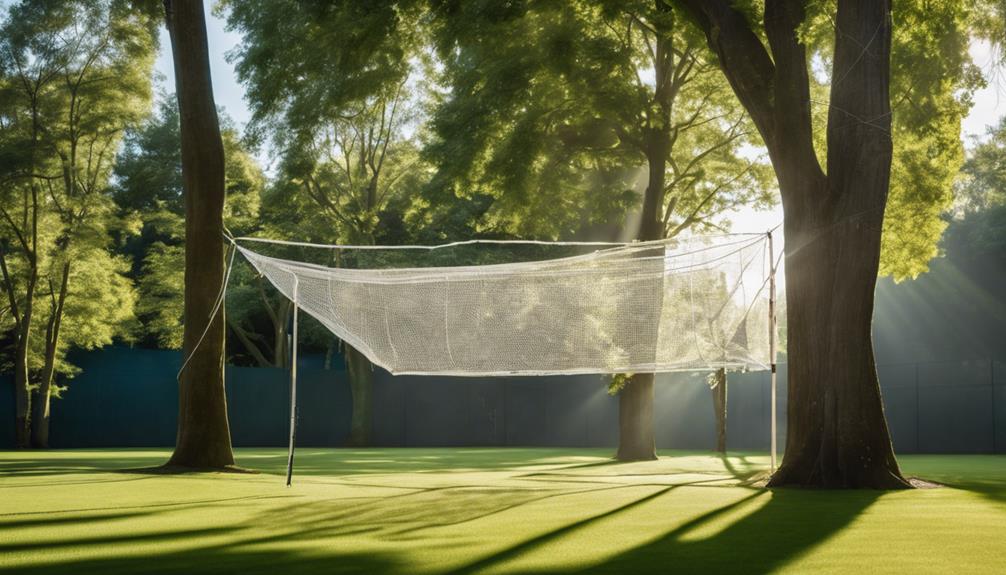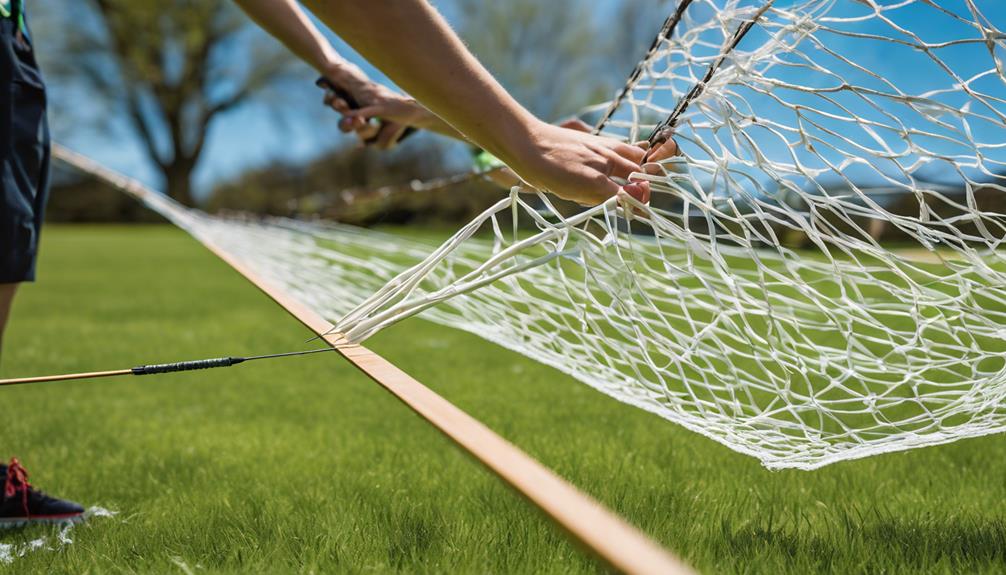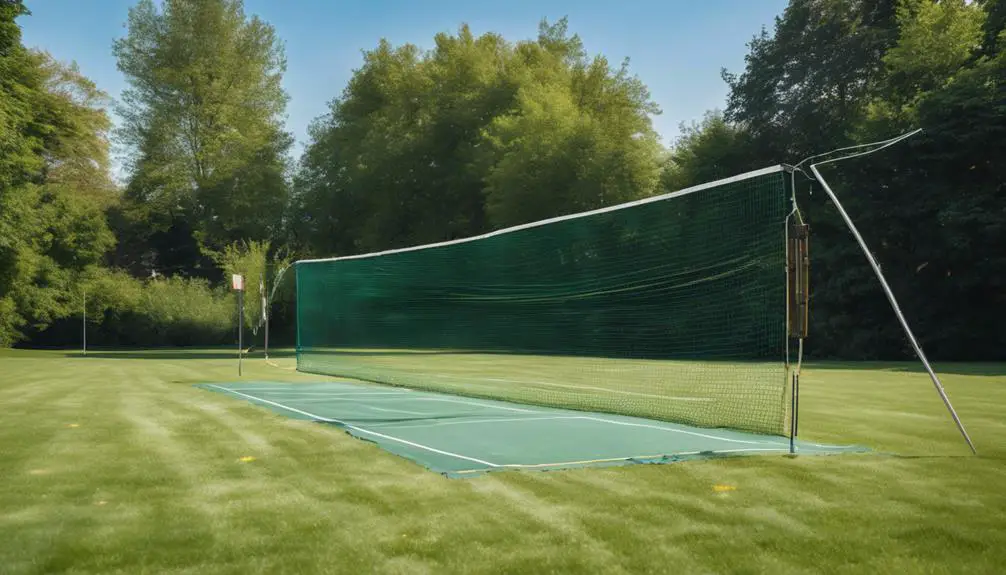To make a badminton net stand, choose a smooth, even surface for installation. Gather durable equipment like nylon or polyester nets, sturdy poles, and tensioning cords. Position the poles securely in weighted bases or use ground stakes for stability. Make certain the net’s height is adjusted to 1.55 meters at the center and 1.524 meters at the ends. Tension the net evenly to prevent sagging, and regularly check for stability during play. Finally, keep maintenance in mind for longevity. With these steps, you’ll create a reliable setup, enabling you to explore even more essential tips for peak performance.
Choosing the Right Location

When selecting the ideal location for your badminton net, consider factors that guarantee peak playability and safety. The court surface is essential; it should be smooth and even to prevent injuries and guarantee optimal shuttlecock movement. Hardwood or synthetic surfaces are preferred, as they provide adequate grip and cushioning.
Next, assess the lighting conditions. Indoor spaces should have bright, even lighting to eliminate shadows and enhance visibility. If you’re playing outdoors, try to position your net where natural light is abundant, avoiding direct sunlight that can affect players’ sightlines. Make sure that the area is well-lit for evening play, as poor lighting can lead to accidents and diminish the overall experience.
Don’t overlook wind factors, especially if playing outdoors. Wind can dramatically affect shuttlecock trajectory, making consistent play more challenging. Ideally, set up your net in a location that minimizes wind interference, such as a sheltered area or with the net aligned parallel to the prevailing wind direction.
Lastly, prioritize player safety. Make certain the surrounding area is free of obstacles like trees, benches, or other hazards that could lead to injuries during intense gameplay. An open space allows players to move freely, reducing the risk of accidents. By carefully considering these factors—court surface, lighting conditions, wind factors, and player safety—you’ll create an ideal environment for enjoyable badminton matches.
Gathering Necessary Equipment
To successfully set up your badminton net, you’ll need several essential pieces of equipment. Start with the net materials; typically, a standard badminton net is made from durable nylon or polyester, which guarantees longevity and performance. Make certain you select a net that meets the official dimensions, as this will enhance your playing experience.
Next, you’ll need the installation tools. A sturdy set of poles is vital, as they provide the necessary support for your net. You can opt for adjustable poles that allow you to customize the height according to regulation standards or personal preference. Additionally, you’ll require a base for your poles to guarantee stability. This can include weighted bases or ground stakes, depending on whether you’re setting up on grass, concrete, or a gym floor.
Don’t forget about the accessories that facilitate installation. A measuring tape will help you position your net accurately, while a level will make certain your poles stand straight. You’ll also want to have a wrench or screwdriver handy for tightening screws or adjusting the net tension.
Lastly, consider using a net tensioning system if you want to maintain ideal net tautness during play. Gather all these materials and tools before you begin; it’ll save you time and guarantee a smooth setup process. With everything in place, you’re ready to move on to assembling the badminton net for an enjoyable game.
Assembling the Badminton Net

Assembling the badminton net involves a few straightforward steps that guarantee it’s set up correctly for peak play. First, gather your net materials—typically, a mesh net, poles, and tensioning cords. Verify the poles are sturdy enough to withstand impacts during gameplay.
Next, follow these assembly techniques to guarantee a seamless setup:
| Step | Action |
|---|---|
| 1. Prepare Poles | Insert the poles into the ground or bases, ensuring they’re vertical. |
| 2. Attach Net | Drape the net over the poles, making sure it’s centered. |
| 3. Secure Edges | Use tensioning cords to pull the edges of the net taut against the poles. |
| 4. Check Height | Verify the net is at the correct height—1.55 meters for men’s and 1.524 meters for women’s singles. |
To maintain the integrity of the net, it’s essential to avoid over-tightening the tensioning cords, as this can lead to wear and tear on the net materials. Adjust the height as needed during assembly to guarantee compliance with regulations.
Securing the Net Posts
Securing the net posts is a essential step in guaranteeing the stability and functionality of your badminton setup. Without proper anchoring, the posts can wobble or fall, disrupting your game. Here are some effective post anchoring techniques you can utilize:
- Concrete Bases: Use heavy concrete blocks or slabs as a stable base for your net posts.
- Ground Stakes: Drive metal stakes into the ground to hold the posts securely.
- Sandbags: Place sandbags around the base of the posts for additional weight and support.
- Tension Cables: Employ tension cables attached to the posts and anchored to the ground for enhanced stability.
- Adjustable Clamps: Use clamps that can be tightened around the posts to prevent any movement.
When selecting net post materials, consider options like aluminum or sturdy steel, which offer durability and resistance to bending. Make sure the posts are at least 1.5 inches in diameter for ideal support.
After determining the best post anchoring techniques, it’s essential to implement them properly. If you choose to use concrete bases, make certain they’re set firmly into the ground, allowing for minimal movement. For sandbags, always check that they’re adequately filled to prevent shifting during play.
Adjusting Net Height

Adjusting the net height is essential for guaranteeing fair play and compliance with official badminton regulations. When you’re setting up your badminton net, understanding the correct height is key to a competitive match. The official height for the net is 1.55 meters at the center and 1.524 meters at the posts. To achieve these precise measurements, you’ll need to employ proper measurement techniques.
Start by measuring from the floor to the top of the net. Use a reliable measuring tape, and consider having someone assist you to guarantee accuracy. If you’re adjusting the height after the initial setup, make sure to double-check your net posts’ stability, so they don’t shift during the process.
Here’s a quick reference table to illustrate the required net heights:
| Net Area | Height (meters) |
|---|---|
| Center of the net | 1.55 |
| Ends of the net | 1.524 |
| Men’s Doubles | 1.55 |
| Women’s Doubles | 1.55 |
Tensioning the Net Properly
Once you’ve confirmed the net is at the correct height, it’s time to focus on tensioning the net properly to maintain its shape and stability during play. Proper tensioning is essential to guarantee that the net performs as expected, regardless of the net material types you’re using.
Here are some tension adjustment techniques to take into account:
- Choose the Right Material: Polyester nets offer durability, while nylon nets provide elasticity—pick based on your play style.
- Use a Tension Gauge: This tool can help you achieve the recommended tension levels, ensuring uniformity across the net.
- Adjust Side Tension First: Start by tightening the sides of the net, which helps distribute tension evenly before you adjust the top.
- Maintain Equal Tension: Confirm that both sides of the net are equally tensioned to prevent sagging or distortion that can affect gameplay.
- Regularly Check Tension: After initial setup, keep an eye on the tension throughout your playing sessions; environmental factors can affect it.
Checking Stability and Balance

Guaranteeing the stability and balance of your badminton net is essential for ideal gameplay; a well-anchored net enhances performance and safety. Start by evaluating the surface types where your net stands. Different surfaces, like grass, concrete, or sand, affect the net’s stability. For example, soft ground may require deeper stakes or additional weights to secure the net, while a hard surface might benefit from a weighted base.
Next, check for wind effects. Outdoor play often exposes your net to varying wind conditions, which can destabilize it during a match. If you’re playing in a breezy environment, consider adding extra weights to the bottom of the poles or using a net designed for wind resistance. This will help maintain the net’s position and guarantee it remains taut, preventing any interruptions to the game.
After setting up, observe the net’s balance. Stand back and visually inspect it from different angles. If one side appears lower or unstable, make adjustments accordingly. You might need to tighten the net or reposition the anchors to achieve an even height across the entire span.
Maintenance Tips for Longevity
To extend the lifespan of your badminton net, regular maintenance is essential, especially after frequent use or exposure to the elements. The right care can greatly enhance the durability of your net, ensuring it remains in top condition for many games. Here are some maintenance tips to keep in mind:
- Inspect Regularly: Check for any signs of wear or damage in the net material. Look for frays, holes, or weak spots that may need repair.
- Clean After Use: Wipe down the net with a damp cloth to remove dirt and debris, particularly if it’s been exposed to outdoor conditions. This helps maintain weather resistance.
- Store Properly: When not in use, store your net in a cool, dry place. Avoid folding it tightly, which can stress the material and lead to premature wear.
- Use a Cover: If your net is outdoors, consider using a protective cover during harsh weather conditions. This adds an extra layer of weather resistance and protects against UV rays.
- Repair Promptly: If you find any damage, repair it immediately to prevent further deterioration. Use appropriate patching materials that match the net material for seamless repairs.
Frequently Asked Questions
Can I Use Any Type of Rope for the Net?
You can’t just use any rope for the net. Consider the net materials and guarantee the rope’s durability matches the intended use. Strong, weather-resistant rope is essential for maintaining the net’s integrity during play.
How Do I Transport a Badminton Net Easily?
Think of a magician’s trick—transporting a badminton net requires clever net storage. Opt for portable nets with compact designs, allowing you to easily carry and set up wherever you want without hassle or heavy equipment.
What Are the Best Surfaces for Setting up a Net?
For ideal net stability, you should choose surfaces like grass, sand, or smooth concrete. Each surface type offers unique benefits, but verify it’s level and firm to maintain the net’s position during play.
Is It Safe to Play Badminton in Windy Conditions?
Playing badminton in windy conditions can be tricky; studies show wind can alter shuttle trajectories by up to 30%. To adapt your game strategy, consider the wind impact on your shots and positioning for better control.
How Do I Clean My Badminton Net?
To clean your badminton net, use mild soap and water for effective maintenance. Avoid harsh chemicals; they can damage the material. Regular cleaning solutions help prolong the net’s lifespan, ensuring peak performance during matches.




